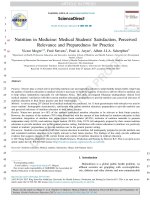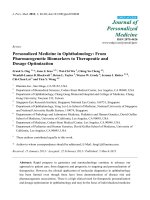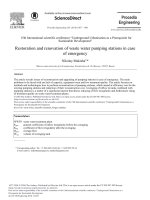Pediatric emergency medicine trisk 1037
Bạn đang xem bản rút gọn của tài liệu. Xem và tải ngay bản đầy đủ của tài liệu tại đây (172.21 KB, 4 trang )
not typically used in the immediate postoperative period given its potential
impact on wound healing. There are case reports of serious complications with
sirolimus as a primary agent in liver (e.g., HAT) and lung (e.g., bronchial
anastomotic breakdown) transplant recipients. Sirolimus is effective for long-term
maintenance and adjunct therapy because it spares the renal system. It is useful as
an antiproliferative agent and may arrest the progression of post heart transplant
graft coronary artery disease. Some studies have suggested a role of sirolimus for
the treatment of de novo autoimmune hepatitis in the transplanted allograft.
Common adverse effects include mouth ulcers, hyperlipidemia, abdominal pain,
marrow suppression, and hypercholesterolemia.
OTHER EMERGENCIES
CLINICAL PEARLS AND PITFALLS
Biliary complications occur in approximately 10% of pediatric liver
transplant recipients and include biliary leaks (early) and biliary
strictures (late).
Recurrence of primary disease can occur in liver or renal transplant
recipients.
BILIARY COMPLICATIONS
Early biliary complications occur in roughly 10% of transplant recipients. The
type of allograft and biliary anastomosis and the status of the hepatic artery
determine the spectrum of complications. Biliary leaks are an early complication
and are more common in recipients of split livers and reduced allografts with
multiple bile duct anastomoses. Later complications typically include biliary
stricture that can lead to biliary sludge formation and recurrent cholangitis.
Biliary strictures can occur in isolation or multiple. Isolated biliary strictures
usually occur at the biliary anastomosis and are more commonly seen with a ductto-duct anastomosis (choledochocholedochostomy). Graft ischemia can lead to
ischemic biliary strictures that may affect all areas of the biliary tree.
Biliary strictures may present with jaundice and pruritus. Early laboratory
findings include elevated bilirubin, GGT, or alkaline phosphatase, often in the
setting of normal or mildly elevated transaminases. Suspicion for biliary
complications should prompt imaging via ultrasound with Doppler to assess for
biliary leaks and hepatic vascular flow. Additional imaging with CT or MRI may
be indicated. Management of biliary strictures may require cholangiography for
placement of a stent to decompress the biliary tree.
RECURRENCE OF PRIMARY DISEASE
The risk of recurrent primary disease is prominent in liver and renal transplant
recipients. Most notable liver diseases with risk of recurrence include
autoimmune hepatitis and bile salt excretory pump (BSEP) disease. For patients
transplanted for autoimmune hepatitis, elevation of transaminases should also
prompt screening for autoimmune hepatitis antibodies including anti-smooth
muscle antibody, anti–liver-kidney microsomal antibody, and antinuclear
antibody. Following transplantation for BSEP, recurrent cholestasis associated
with immunoglobulin G antibodies can develop. Management with rituximab, a
monoclonal anti-CD20 antibody, in combination with intravenous
immunoglobulin and plasmapheresis has been used, but retransplantation may be
indicated in some cases.
The risk of recurrence of primary disease in renal transplant patients depends
on the primary disease. Diseases that commonly recur are membranoproliferative
glomerulonephritis, IgA nephropathy, and focal segmental glomerulosclerosis.
Graft loss due to recurrent glomerulonephritis is the third most common cause of
graft failure, yet the impact of recurrence greatly varies according to the primary
disease.
ACKNOWLEDGMENT
The authors of this chapter acknowledge Anne Bernis, RPh, for her contributions
to Table 125.1 , interactions between transplant immunosuppressents and other
commonly used medications.
Suggested Readings and Key References
Posttransplant Infections
Arslan H, Inci EK, Azap O, et al. Etiologic agents of diarrhea in solid organ
transplant recipients. Transpl Infect Dis 2007;9(4):270–275.
Haddad J Jr, Inglesby T, Addonizio L. Head and neck infections in pediatric
cardiac transplant patients. Ear Nose Throat J 1995;74(6):422–425.
Jordan CL, Taber DJ, Kyle MO, et al. Incidence, risk factors, and outcomes of
opportunistic infections in pediatric renal transplant recipients. Pediatr
Transplant . 2016;20(1):44–48.
Zaoutis TE, Webber S, Naftel DC, et al. Invasive fungal infections in pediatric
heart transplant recipients: incidence, risk factors, and outcomes. Pediatr
Transplant 2011;15(5):465–469.
Graft Rejection
Adams DH, Neuberger JM. Treatment of acute rejection. Semin Liver Dis
1992;12:80–88.
Costanzo MR, Dipchand A, Starling R, et al. The International Society of Heart
and Lung Transplantation Guidelines for the care of heart transplant recipients.
J
Heart
Lung
Transplant
2010;29(8):914–956.
doi:10.1016/j.healun.2010.05.034.
Posttransplant Lymphoproliferative Disorder
Absalon MJ, Khoury RA, Phillips CL. Post-transplant lymphoproliferative
disorder after solid-organ transplant in children. Semin Pediatr Surg
2017;26(4):257–266.
Dayton JD, Richmond ME, Weintraub RG, et al. Role of immunosuppression
regimen in post transplant lymphoproliferative disorder in pediatric heart
transplant patients. J Heart Lung Transplant 2011;30(4):420–425.
Kerkar N, Morotti RA, Madan RP, et al. The changing face of posttransplant
lymphoproliferative disease in the era of molecular EBV monitoring. Pediatr
Transplant 2010;14:504–511.
Kinch A, Baecklund E, Backlin C, et al. A population based study of 135
lymphomas after solid organ transplantation: the role of Epstein Barr Virus,
hepatitis C and diffuse large B cell lymphoma subtype in clinical presentation
and survival. Acta Oncol 2014;53(5):669–679.
Narkewicz MR, Green M, Dunn S, et al. Decreasing incidence of symptomatic
Epstein-Barr virus disease and posttransplant lymphoproliferative disorder in
pediatric liver transplant recipients: report of the studies of pediatric liver
transplantation experience. Liver Transpl 2013;19:730–740.
Webber SA, Naftel DC, Fricker FJ, et al. Lymphoproliferative disorders after
paediatric heart transplantation: a multi institutional study. Lancet
2006;367:233–239.
Vascular Complications
Babyn PS. Imaging of the transplant liver. Pediatr Radiol 2010;40:442–446.
Immunosuppressant Medication–Related Complications
Blondet NM, Healey PJ, Hsu E. Immunosuppression in the pediatric transplant
recipient. Semin Pediatr Surg 2017;26(4):193–198.
Bucuvalas JC, Alonso E, Magee JC, et al. Improving long-term outcomes after
liver transplantation in children. Am J Transplant 2008;8:2506–2513.
Campbell K, Ng V, Martin S, et al; SPLIT Renal Function Working Group.
Glomerular filtration rate following pediatric liver transplantation—the SPLIT
experience. Am J Transplant 2010;10:2673–2682.
Keogh A, Richardson M, Ruygrok P, et al. Sirolimus in de novo heart transplant
recipients reduces acute rejection and prevents coronary artery disease at 2
years: a randomized clinical trial. Circulation 2004;110:2694–2700.
Other
D’Alessandro AM, Kalayoglu M, Sollinger HW, et al. The predictive value of
donor liver biopsies on the development of primary nonfunction after
orthotopic liver transplantation. Transplant Proc 1991;23:1536–1537.
Racadio JM, Kukreja K. Pediatric biliary interventions. Tech Vasc Interv Radiol
2010;13:244–249.
Todo S, Demetris AJ, Makowka L, et al. Primary nonfunction of hepatic
allografts with preexisting fatty infiltration. Transplantation 1989;47:903–905.
Yersiz H, Renz JF, Farmer DG, et al. One hundred in situ split liver
transplantations: a single-center experience. Ann Surg 2003;238:496–505;
discussion 506–507.









